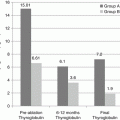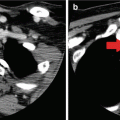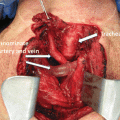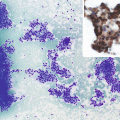Year
Diseasea
Study size
Age
Size
Extent/T-stage
Lymphnode status
Metastases
Gender
Grade
Histology
Others
No. of riskgroups
EORTC
1979
PTC, FTC,MTC, ATC
507
X
X
X
X
X
5
AGES
1987
PTC
860
X
X
X
X
2
AMES
1988
PTC, FTC
814
X
X
X
X
2
Clinical class
1990
PTC
269
X
X
X
4
MACIS
1993
PTC
1779
X
X
X
X
Completeness of resection
4
SAG
1993
PTC
173
X
X
X
3
Ohio State
1994
PTC, FTC
1355
X
X
X
X
Multifocal disease
4
Noguchi
1994
PTC
2192
X
X
X
X
3
MSK
1994
PTC, FTC
1038
X
X
X
X
3
Munster
1997
PTC, FTC
500
X
X
2
NTCTCS
1998
PTC, FTC,MTC, ATC
1607
X
X
X
X
X
4
UAB/MDA
2000
PTC
208
X
X
3
Murcia
2000
PTC
200
X
X
X
X
3
Tokyo
2004
PTC
604
X
X
X
X
2
Ankara
2005
PTC, FTC
347
X
X
X
X
4
CSMC
2013
PTC, FTC
1622
X
X
X
X
3
TNM
2009
PTC, FTC, MTC, ATC
X
X
X
X
X
4
Two of the early prognostic systems reviewed here, EORTC and AGES, both included some kind of tissue or cellular level information as part of their prognostic model [4, 5]. However, their definitions of tumor grade proved difficult to apply broadly to patients at a variety of institutions with different pathologists and reporting standards. The MACIS criteria were derived for just such a reason. Hay and colleagues realized that while tumor grade as described in the AGES criteria was important, it was not universally available and standardized, thus limiting its practicality when trying to develop a universal prognostic system [8]. It should be noted that the MACIS criteria were developed over 20 years ago, and our understanding of tumor biology has grown exponentially since that time. As our understanding of tumor biology continues to evolve, it becomes increasingly clear that factors including the cancer subtypes (papillary tall cell, Hurthle cell, etc.) and specific molecular variants are important in the prognosis of differentiated thyroid cancer. While a number of studies have attempted to correlate a particular molecular marker with prognosis, none have yet been successfully applied across a wide variety of patients and institutions. As we are able to better correlate clinical outcome with particular molecular features, prognostic systems that incorporate these markers will need to be developed.
Prognostic Systems
EORTC 1979
Most point to 1979 for the first published prognostic scoring system for thyroid cancer. In that year, David Byar and colleagues from the EORTC performed a multivariate analysis of 507 patients with thyroid cancer and created a scoring system based on age, sex, histology, T-stage, and the presence or absence of metastasis. They then stratified the patients into five groups and used the observed survival data in their cohort to predict survival [4]. Their patient set included medullary and anaplastic thyroid cancers in addition to papillary and follicular, but it paved the way for the future prognostic systems in differentiated thyroid cancer. Some authors will cite this paper as the reason the age of 45 is used as the cutoff in risk stratification systems [9], but Byar et al. treated age as a continuous variable with patients assigned more points as they got older. They did show increased mortality with increasing age that started in the 41–50 age range, so perhaps that is why age 45 was used by so many of the prognostic systems formulated after theirs.
AGES 1987
Ian Hay and colleagues at the Mayo Clinic next proposed a novel scoring system in 1987. Their system used age, tumor grade, extent, and size to predict survival. It analyzed 860 patients with papillary thyroid cancer and found that patients with an AGES score of 3.99 or less had observed 25-year mortality of 1% for patients who had ipsilateral lobectomy and 2% for patients who had a total thyroidectomy. In contrast, patients with an AGES score of 4 or higher had a 25-year disease-specific mortality of 65% for patients treated with ipsilateral lobectomy compared to only 35% for those who had a total thyroidectomy (p = 0.06) [5].
AMES 1988
The Lahey Clinic published their own staging system in 1988, later dubbed the AMES staging system. In their cohort of 814 patients with differentiated thyroid cancer, age, distant metastasis, extent, and size of the primary tumor were predictive of mortality. Age and size were both treated as categorical variables, with size >5 cm and age >41 for men and age >51 for women all predictive of an increased risk of death. Using these criteria, 89.4% of their patients were classified as low risk with a 1.8% risk of mortality, while the other 11% were high risk with a mortality rate of 46% [6].
Clinical Class 1990
Researchers at the University of Chicago were next to publish a risk stratification system dubbed the clinical class staging system. It was based solely on the extent and spread of the disease: class I was intrathyroidal disease, class II cervical node metastases, class III extrathyroidal invasion, and class IV distant metastases. They found that most of the deaths occurred in classes III and IV, with class III conferring a 5.8-fold increased risk of death and class IV a 47-fold increased risk of death. Class II patients were found to have an increased risk of recurrence but not an increased risk of death. Interestingly, they found that age over 45 and size >3 cm increased the risk of death by 32 and 5.8, respectively, but neither was included in their predictive model [34].
MACIS 1993
Ian Hay and colleagues published a new prognostic system in 1993, just 6 years after the publication of their AGES scoring system. While the AGES system was well validated, many centers did not report grade for papillary thyroid cancer, so the authors wanted a prognostic system that had more general applicability. Their cohort of 1779 patients was divided into two groups sorted by treatment date: 764 who had surgery between 1940 and 1976 and 1065 who had surgery 1965–1989. The first group was used to develop the prognostic model, and the second group was used to test the model. The model incorporated five variables: metastasis, age, completeness of resection, invasion into surrounding structures, and size (MACIS). The final formula was 3.1 (if aged < or = 39 years) or 0.08 × age (if aged > or = 40 years), + 0.3 × tumor size (in centimeters), +1 (if incompletely resected), +1 (if locally invasive), and +3 (if distant metastases present). The 20-year disease-specific survival rates for scores of <6, 6–6.99, 7–7.99, and 8+ were 99%, 89%, 56%, and 24%, respectively (p < 0.0001) [8].
While it only evaluated papillary thyroid cancer, the MACIS prognostic system has been well validated over the years. Lang et al. analyzed 14 different prognostic staging systems for papillary thyroid cancer developed between 1979 and 2005. They found that the MACIS scoring system most accurately predicted disease-specific survival in their cohort of 587 patients with papillary thyroid cancer [38]. D’Avanzo et al. analyzed 86 patients with follicular thyroid cancer and found that the MACIS scoring system was the most accurate in predicting disease-specific survival in their cohort [39]. Despite being initially developed for papillary thyroid cancer, the MACIS scoring system is applicable to both papillary and follicular cancers and remains one of the best predictive models for differentiated thyroid cancer. In its 2015 guidelines, the American Thyroid Association recommends the MACIS system along with the TNM staging system from the American Cancer Society as its preferred staging and prognostic systems [40].
SAG 1993
In contrast to the MACIS scoring system, the SAG scoring system emphasizes tumor grade as an important prognostic feature. Published by Lars Akslen from the University of Bergen in Norway, he found that histologic grade based on nuclear atypia, tumor necrosis, and vascular invasion was a strong prognostic factor in a cohort of 173 patients with papillary thyroid cancer. His scoring model incorporates sex, age, and grade, and patients were stratified into three SAG groups. Group 3, made up of male patients over 70 with high-grade tumors, had a significantly higher death rate, 51.5% at 10 years compared to 9.3% and 1.3%, respectively, from SAG II and SAGI [36].
Ohio State Criteria 1994
The Ohio State University system was published by Mazzaferri and Jhiang based on a cohort of 1355 patients from US Air Force and Ohio State University hospitals. It included both papillary thyroid cancer and follicular thyroid cancer. They divided patients into four groups, or stages, based on tumor size, lymph node involvement, multifocality, local tumor invasion, and distant metastases. Stage I patients had tumors <1.5 cm in diameter; stage II, tumor size between 1.5 and 4.4 cm or presence of cervical lymph node metastases or more than three intrathyroidal foci of tumor; stage III, tumors at least 4.5 cm or presence of extrathyroidal invasion; and stage IV, distant metastases. Their staging system is unique in that it incorporates multifocality in addition to the more commonly used factors like size, lymph node status, and metastases. They also report on recurrence rate in addition to cancer-specific mortality. They found that patients with stage II and stage III papillary and follicular cancers had similar mortality rates for similar disease burden at presentation [29].
Noguchi 1994
Researchers from the Noguchi Thyroid Clinic in Japan published their staging system in 1994 based on a cohort of 2192 patients with papillary thyroid cancer. Their staging system divided men and women into three groups based on gender, age, tumor size, and gross lymphadenopathy. They found that survival for men and women was dependent on different prognostic factors and thus staged them separately. For men, only two factors were found to be predictive: age and nodal status. The low-risk or excellent group included all men younger than 45 and patients up to age 60 without gross nodal metastasis. The intermediate group included patients ages 45–55 with gross nodal metastasis and patients over 60 without gross nodal involvement. The poor group included all patients over 55 with nodal metastasis. Ten-year survival for the three groups was 98.4%, 90.1%, and 74.4%, respectively. For women, tumor size was predictive in addition to age and gross lymphadenopathy. The excellent group included all females up to age 50 plus patients 50–55 without gross nodal metastasis. The intermediate group included patients ages 50–55 with gross nodal involvement, ages 55–65 with no nodal involvement, and age 65+ with no gross nodal involvement whose primary tumors were less than 3 cm. The poor group was any patient over 55 with gross nodal involvement and patients over 65 with a primary tumor >3 cm. Survival for the three groups was 99.3%, 96.4%, and 88.8%, respectively at 10 years [37].
Memorial Sloan Kettering (MSK) 1994
Memorial Sloan Kettering published their prognostic system in 1994 based on a cohort of 1038 patients with differentiated thyroid cancer. Their scoring system takes grade, age, size, and distant metastases into account. Patients were stratified into low-, intermediate-, and high-risk groups according to the following criteria: low-risk patients were those younger than 45 with tumors <4 cm, no distant metastases, and with papillary thyroid cancers. Intermediate-risk patients included those younger than 45 with either distant metastases, tumor >4 cm, or follicular thyroid cancer on pathology or age <45 with no sign of distant metastases, tumors <4 cm, and papillary thyroid cancer. High-risk patients were those 45 with either distant metastases, tumors >4 cm, or follicular thyroid cancer. With a median follow-up of 20 years, disease-specific survival was 99%, 85%, and 57%, respectively. They make it a point to highlight that the intermediate-risk group includes both low-risk patients with high-risk tumors and higher-risk patients with low-risk tumors [30].
University of Munster 1997
Researchers from the University of Munster analyzed 500 patients with differentiated thyroid cancer including almost 40% with follicular thyroid cancer. Patients were stratified into low- and high-risk groups. High-risk patients were those with either a T4 (locally invasive) or M1 (distant metastatic) disease. All others were considered low risk. With a median follow-up of 5 years, there were no disease-specific deaths in the low-risk group and disease-specific survival in the high-risk group was 83%. Age was found to be statistically significant in multivariate analysis with a relative risk of death of 4.67 but was not included in the prognostic system. Lymph node status was evaluated, but on multivariate analysis was not an independent predictor of mortality leading the authors to conclude that the higher mortality of positive lymph nodes seen on univariate analysis is due to the coincidence with local invasion and distant metastases [33].
National Thyroid Cancer Treatment Cooperative Study (NTCTCS) 1998
The National Thyroid Cancer Treatment Cooperative Study was a prospective, multi-institution study involving 14 university centers and 1607 patients registered from 1987 to 1995. Median follow-up was 40 months. The study included patients with anaplastic and medullary thyroid cancer in addition to papillary and follicular. Differentiated thyroid cancer patients accounted for about 93% of the cohort. Prognostic factors evaluated included age, tumor size, tumor type, extrathyroidal invasion, lymph node, and distant metastases. Patients were stratified into four clinical stages. Factors most predictive of prognosis for papillary cancer included age, size, extrathyroidal invasion, and metastases. For follicular thyroid cancer, age, size, distant metastases, and poor differentiation were predictive. Table 16.2 shows how the patients were stratified into the various stages. Disease-specific survival was 99.8% for stage I, 100% for stage II, 91.9% for stage III, and 48.9% for stage IV [31]. Since its publication in 1998, the NTCTCS staging system has been independently verified and found to be one of the most accurate staging systems for predicting disease-specific survival [35].
Table 16.2




Methods for risk calculation [38]
Stay updated, free articles. Join our Telegram channel

Full access? Get Clinical Tree








